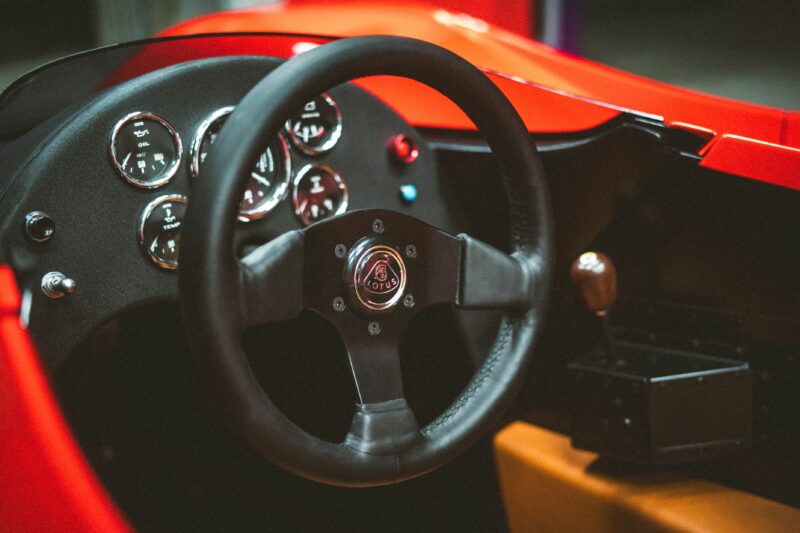Lots of Torque Usually Sideways – the Story of a Lost Lotus

Some things are just better together. Salt and vinegar. Rock and roll. Small British sports cars and improbably large V8 engines. Think AC Cobra, TVR Griffith or Sunbeam Tiger. It’s a classic combination, but not perhaps one that immediately springs to mind when you think of Lotus. Except, the Norfolk firm does have its own history when it comes to these brawny automotive mashups, and it’s busy writing a new chapter right now. This is the story of the lost Lotus.

The Lotus Type 66 is a brand new track car that pays homage to the fearsome Can Am racers of the sixties and seventies. Just 10 examples will be built at a cool £1.1 million each. Depending on your perspective, that’s either an awful lot of money for a car that doesn’t even come with a roof or something of a bargain for a limited edition collector’s piece. For comparison, it’s a third of the price of Aston Martin’s DB5 Goldfinger Continuation model or roughly one quarter of a Bugatti Bolide.
 Colin Chapman in the Lotus 49 F1 racer
Colin Chapman in the Lotus 49 F1 racer
The story of the Type 66 stretches back to 1969. Lotus was on a roll, having picked up its third Formula 1 constructors’ title the year before; road car sales were soaring, and the brand had become a pop culture icon thanks to its motorsport success and some canny product placement in TV series like The Avengers and The Prisoner. Company founder Colin Chapman was an engineering genius, but he was also an astute businessman. He understood the value of the North American market, where the motto among sports car firms was “race on Sunday, sell on Monday”. Lotus had already triumphed at the Indy 500, becoming the first European manufacturer to do so since World War Two, but when it came to sports car racing, the biggest prize was the Can Am series, or Canadian-American Challenge Cup to give it its full name.

Beginnings
Established in 1965, Can Am ran to a more liberal set of regulations than the Group 6 prototypes that raced at European events like Le Mans. The saying went that the first rule of Can Am is that there are no rules. Like Fight Club but with V8s.
Lotus had already had an unsuccessful foray into the North American sports car racing scene. It was one of the manufacturers that had pitched for the GT40 project in 1963. When that deal went to Lola instead, Chapman and his team continued their development, producing a mid-engined V8 sports racer called the Type 30, which was followed by the Type 40. Neither were a great success, but their backbone chassis concept later formed the basis of the four-cylinder Lotus Europa and, ultimately, the Esprit.

By 1969, Chapman was ready to have another go. He instructed draughtsman Geoff Ferris to begin preparing sketches for a Can Am car using Lotus’ latest F1-winning knowhow. It was granted an official Lotus model number, the Type 66, but sometime after that the project stalled. Known only to a handful of people at Team Lotus, it was very nearly a lost Lotus, consigned to the history books.

One day, Colin Chapman’s son Clive stumbled across a roll of microfilm while looking for some old Formula 1 drawings. To his surprise, one of them contained a set of sketches for a Can Am car. Word of the lost Lotus soon spread, and in 2016 Motorsport approached Chapman to write an article on the car for a special feature on Can Am’s 50th anniversary. As a favour, Chapman asked Lotus design director Russell Carr if he could turn the 2D drawings into a 3D model to illustrate the article.

Carr immediately said yes, despite not having any official time allocation to devote to the lost Lotus in the design studio. Instead, he took it on as an out-of-hours project, working in collaboration with designers Barney Hatt and Pete Reach. They were so taken with the car that they used the design studio’s CNC milling machine to create a physical model that now sits on the shelf in Carr’s office.

A new old car
Skip forward to the beginning of 2022, and Lotus’ newly appointed head of Advanced Performance, Simon Lane, was looking for a special project to celebrate the company’s upcoming 75th anniversary. He called in to see Carr who showed him the model of the Type 66. “When Russell told me the story, it felt like the automotive equivalent of coming across an unreleased Beatles single. It seemed like the perfect way to celebrate the 75th anniversary,” he recalls.

Lane had been involved in continuation cars with a previous employer and was wary of creating a direct copy: “If you build a car to a 1960s design, it will drive like a 1960s car, and it will have 1960s safety levels,” he comments. “We decided to approach it as a restomod, in a way that would stay true to the look and feel of the original design, but with modern engineering that would make it safe and fun.” The only fundamental change to the silhouette is that the wheelbase has been lengthened fractionally so the crumple zone is now provided by an FIA-grade crash structure rather than the driver’s ankles. Under the skin, the chassis is a completely new design, as the original drawings only featured the exterior. You’d be hard pushed to tell, however, with a period-correct aluminium honeycomb outer skin (albeit underpinned by modern extruded aluminium sections and bonded together).

Power comes from a 5.8-litre pushrod V8 pumping out an earth-trembling 830bhp at 8,800 rpm and redlining at 9,000 rpm. Original Can Am cars were, in Lane’s words, “terrifying and pretty dangerous”, so to save its customers from a fiery death, Lotus has fitted motorsport ABS and traction control, as well as a modern sequential gearbox with over-rev and downshift protection.

Will these modern refinements spoil the authenticity of the Type 66? Perhaps for purists and a handful of highly skilled racers who’d actually be capable of manhandling it around Laguna Seca with an H-gate gearbox and nothing but their right foot for traction control. And for the rest of us? Maybe we should just be glad that in a world of 2.5-tonne electric SUVs and Level 4 autonomy, Lotus still chooses to produce something so analogue, so intriguing and so deeply, deeply bonkers. Bravo.


